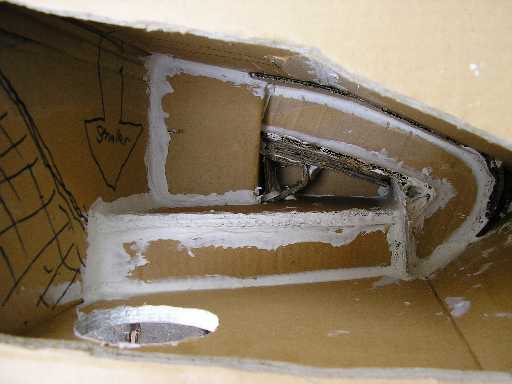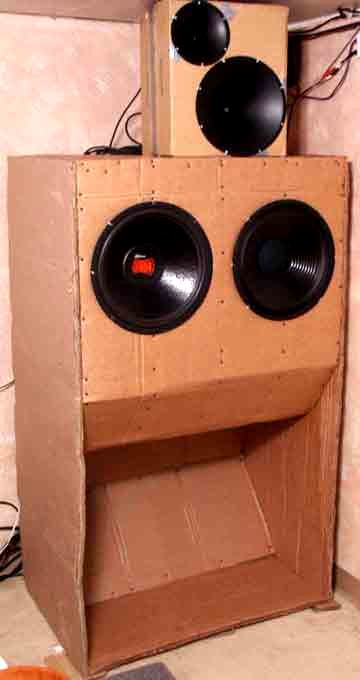please note this website is permanantly "under construction", or possibly not constructed properly in the first place
note also that designs shown,are mostly "under construction" or...
to go back to the main page, press here
1/2 scale Jensen Imperial back horn
To celebrate the approx. 50th birthday of the Jensen Imperial,
I have built a half scale version out of cardboard(!).
I simply divided the all of the internal dimensions in the plan by 2.
The original horn is 40Hz hyperbolic horn with M=0.7
A half scale horn is 80Hz hyperbolic horn with M=0.7

CONSTRUCTION:
Sides were made using 2 layers of double thickness cardboard, laminated using "no more gaps" silicon calking compound. Internal dimensions of the horn path from the original design were divided by 2 and drawn on to one of the sides. The compression chamber was constructed separately and everything stuck together with "no more gaps" making sure to seal the ends of the cardboard. Speaker cut-outs were also sealed.
The photo above shows the horn mouth at the bottom.
The original design has a constant width horn path which follows the back of the enclosure to the top where it turns 45 degees toward the front of the enclosure to the throat.
In my prototype I wanted a longer horn path to experiment with different throat sizes. I used the exponential horn calculator from the Single driver website, to calculate a longer horn path. I altered the original design by gradually reducing the width of the horn path, while still maintaining the correct area expansion for 80Hz M=0.7
The horn wall is drawn on the top of the box in the photo below.

The photo below shows the full extent of the lengthened horn, curled around inside the chamber. I built a small compression chamber on the end and tried a 4" driver firing out the side.
My favorite cheap Jaycar 5 inch driver sounded the best mounted as per the top photo, in the horn with no real compression chamber. The unused part of the horn was stuffed with socks in a plastic bag to seal it off.

I am very impressed with the improvement in the bass that has a dynamic quality.
There are resonances, especially when the walls are as thin as these. I stiffened the back of the enclosure with some 19mm X 42mm pine, stuck on the outside. I have also stuffed clothes in voids and placed tins and a bag of apples on top to damp the resonance from the throat.
Other information:
After Keele and Edgar mass rolloff = 2Fs/Qes where Fs is the flare frequency. To calculate optimum throat size, use St=0.8fs Qes Vas where St is in sq inches and Vas is in cubic feet. I found that these calcs predicted the actual results very well. I messed up using metric and this formula for throat size St=2 PI Fs Qes Vas/C where c= the velocity of sound. The units are obviously important. If you are a loser at math like me, be careful.
The mouth size for a horn is dictated by the frequency and the space it is radiating into.
1/2 space, or size factor=2 used on the floor
1/4 space, or size factor=4 used on the floor and against a wall
1/8 space, or size factor=8 used in a corner on the floor
The full size imperial has a mouth size at 40Hz a bit larger than 1/8 space, about 1/6 space. I found that the half scale version only worked well against a wall or near a corner.
I think part of the magic of the imperial is that it only uses 45 degree bends which have been shown to produce less turbulence. The other part of the magic (and difficulty in driver selection) is the way it matches a relatively high Fs speaker to the horn by using a hyperbolic expansion. The following is from an article (JOURNAL OF THE AUDIO ENGINEERING SOCIETY OCTOBER 1953, VOLUME 1, NUMBER 4 Design Factors in Horn-Type Speakers by DANIEL J. PLACH) written by one of the designers of the imperial: "Maximum efficiency in a horn unit can be achieved only if a conjugate match exists between driver and horn. This match is possible only if the unloaded resonance of the driver is greater than horn cutoff frequency."
MORE IMPERIALS:
Here is a link to Steve_Mac's scaled UP version.
Here is a photo of a FULL SIZE HALF WIDTH prototype built out of boxes and duct tape, made by another Steve and using a car sub. I love it!

Here is a photo of a FULL SIZE FULL WIDTH Imperial, also made by the previous Steve. Possibly the most awsome cardboard speaker ever built! And yes folks that is 2 X 15" drivers in there!

Click to go to the Decware Imperial forum for even more talk about the king of loudspeakers